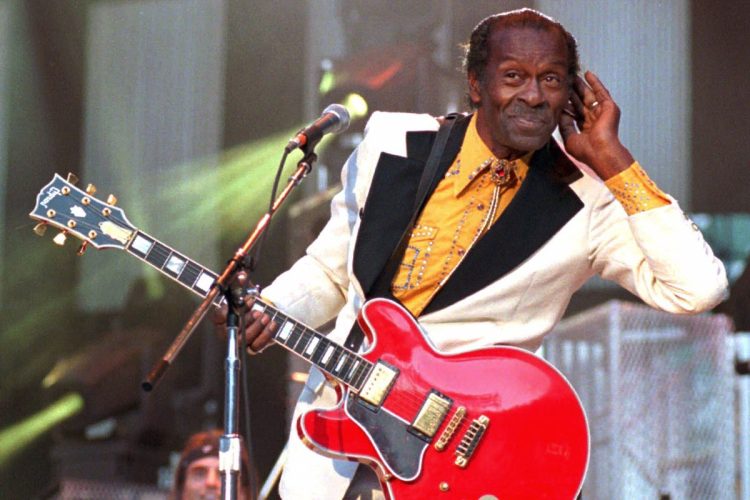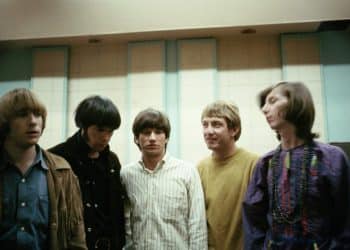Few names in music history shine as brightly as Chuck Berry’s. Known as the undisputed “Father of Rock ‘n’ Roll,” Chuck Berry revolutionized the music scene, weaving together electrifying guitar riffs, soulful lyrics, and an energy that defined an entire genre. From the 1950s onwards, his groundbreaking sound inspired countless artists—from The Beatles and The Rolling Stones to Bruce Springsteen and beyond—cementing his legacy as one of the most influential figures in music history.
In this article, we take a thrilling journey through Chuck Berry’s most iconic tracks—the songs that got people twisting and shouting, racing down highways, and dreaming of better days. Each of these hits showcases Berry’s unparalleled ability to capture the spirit of rebellion, freedom, and youthful exuberance that rock ‘n’ roll is built on. Whether you’re a lifelong fan or just discovering his genius, this list will have you tapping your feet, strumming air guitar, and falling in love with the timeless magic of Chuck Berry.
So, buckle up and get ready to revisit the unforgettable melodies and lyrics that shaped rock ‘n’ roll forever. Here are the top 10 most popular Chuck Berry songs of all time—pure dynamite for your ears!
1. Johnny B. Goode (1958)
“Johnny B. Goode” is, without a doubt, Chuck Berry’s most iconic song, and it remains a cornerstone of rock-and-roll history. Released in 1958, the track tells the story of a young, talented guitarist, Johnny, who dreams of stardom despite his humble beginnings. The song’s high-energy tempo, catchy lyrics, and the legendary guitar riff have made it one of the most recognizable tunes in music history. What makes this song so special is its autobiographical elements, as it reflects Chuck Berry’s own rise in the music world, mirroring the journey of a young musician determined to make a name for himself. The song’s optimistic message and narrative of perseverance perfectly capture the spirit of rock-and-roll, celebrating the idea that anyone can achieve greatness with enough passion and drive. Over the decades, “Johnny B. Goode” has become an anthem for aspiring musicians, a testament to the power of rock-and-roll to inspire and uplift. Its influence can be heard in countless songs that followed, making it a true classic. Even today, this song’s infectious energy and timeless sound continue to define the very essence of rock music.
2. Roll Over Beethoven (1956)
Released in 1956, Chuck Berry’s “Roll Over Beethoven” is a bold declaration that rock-and-roll was here to stay, a genre that would eventually surpass classical music in both popularity and relevance. With its upbeat tempo, driving rhythm, and clever, rebellious lyrics, this song challenged traditional norms and celebrated the youth culture of the time. In the track, Berry exclaims that rock-and-roll is the new sound that should be heard over the old classical tunes, humorously instructing Beethoven to “roll over” and make way for the electric guitar. The song’s energy is infectious, and it embodies the joy and freedom that rock music brought to the post-war generation. The catchy riff and punchy beat laid the groundwork for future rock musicians and fans alike, solidifying Chuck Berry as a pioneer of the genre. “Roll Over Beethoven” wasn’t just a catchy tune; it was a cultural statement, declaring that the world was ready for a new form of expression. The song quickly became a timeless anthem, and it continues to resonate with listeners who appreciate the boldness and rebellion that defined the early days of rock-and-roll.
3. Maybellene (1955)
Chuck Berry’s debut single, “Maybellene”, released in 1955, is often credited as one of the songs that shaped the sound of rock-and-roll. Blending elements of rhythm and blues with an uptempo beat, this track was revolutionary at the time and marked a turning point in the development of rock music. The song tells the story of a man who’s chasing after his unfaithful lover, Maybellene, leading to a high-speed car chase. It’s a tale of jealousy, infidelity, and the thrill of a race, set to an electrifying rhythm that hooks the listener from the first note. Berry’s ability to blend storytelling with rock instrumentation gave the song its unique flair, making it stand out in a world where blues and R&B dominated. What’s especially significant about “Maybellene” is the way it redefined rhythm and blues; Berry’s fast-paced guitar riffs and innovative use of up-tempo rhythms created a blueprint for the future of rock music. “Maybellene” wasn’t just a hit — it was a game-changer, showcasing Chuck Berry’s genius and establishing him as one of the most influential figures in the birth of rock-and-roll.
4. Sweet Little Sixteen (1958)
“Sweet Little Sixteen”, released in 1958, is a quintessential Chuck Berry song that captures the essence of the teenage rock-and-roll experience. The song tells the story of a young girl, just sixteen years old, who is obsessed with music, dancing, and dreaming of stardom. Berry’s storytelling shines through as he vividly describes the girl’s passion for rock-and-roll, constantly thinking about her favorite bands and the thrill of attending concerts. The song’s catchy melody, paired with its upbeat tempo, makes it instantly recognizable, and its infectious energy captures the spirit of a new, youthful generation embracing the rock-and-roll lifestyle. “Sweet Little Sixteen” also marks a shift toward youth-centered themes in rock music, celebrating the excitement and freedom that came with adolescence. The track’s energetic piano riff and lively guitar solo, combined with Berry’s dynamic vocals, make it an enduring favorite. It became one of Berry’s biggest hits and solidified his place in rock history. Even decades later, the song’s catchy refrain, “Sweet little sixteen, she’s got the grown-up blues,” remains iconic, making it a standout in Chuck Berry’s legendary catalog.
5. Rock and Roll Music (1957)
Released in 1957, “Rock and Roll Music” is a high-energy celebration of the genre itself. Chuck Berry’s unwavering enthusiasm for rock-and-roll is palpable in this track, which is a joyful declaration of love for the music that was changing the world. The lyrics are simple, but effective: Berry sings about the power of rock-and-roll to lift people’s spirits and unite them through the universal language of music. With its upbeat rhythm and catchy guitar riffs, “Rock and Roll Music” is a song that invites listeners to dance and sing along, encapsulating the pure joy and excitement of rock-and-roll. The song is as much a tribute to the genre as it is a call to action for anyone who loves music to join in the movement. Berry’s guitar work in this track is exceptional, and his vocals are full of energy, capturing the infectious spirit of rock-and-roll. “Rock and Roll Music” became a massive hit and has since been covered by numerous artists, further solidifying its status as an anthem of the genre. The track remains a timeless reminder of the freedom, energy, and unifying power of rock-and-roll.
6. School Days (1957)
“School Days” (1957) is a nostalgic, upbeat tune that transports listeners to the carefree days of teenage life. The song captures the essence of school years, with its mix of mundane routines and the sense of freedom that comes with being young. Chuck Berry’s clever lyrics paint a picture of the excitement of skipping school, hanging out with friends, and dreaming of rock-and-roll fame. The rhythm of the song matches the lively nature of youth, with a bouncy beat and catchy guitar riff that makes it impossible not to tap your feet. What stands out in “School Days” is how it bridges the gap between the frustrations of school life and the freedom of rock-and-roll. For young listeners, it served as a reminder that there was a world of excitement waiting beyond the classroom. For older listeners, it’s a trip down memory lane, evoking the carefree days of their youth. The song also reflects Berry’s understanding of his audience, as teenagers everywhere could relate to the excitement and energy of rock-and-roll. “School Days” became a beloved anthem, and its cheerful, upbeat spirit continues to make it one of Chuck Berry’s most memorable songs.
7. No Particular Place to Go (1964)
Released in 1964, Chuck Berry’s “No Particular Place to Go” is a playful and carefree tune that captures the fun and spontaneity of a romantic drive. The song tells the story of a couple out on a ride, where things go humorously wrong, leading to an awkward situation in which the narrator is stuck in a car with no real destination. The lighthearted lyrics, combined with the catchy, upbeat rhythm, create a fun narrative that showcases Chuck Berry’s knack for storytelling. The song’s smooth guitar riff and easygoing tempo give it a laid-back vibe, but it still carries the signature energy of Berry’s music. “No Particular Place to Go” is full of humor, wit, and relatable situations, making it a classic in Berry’s catalog. The track highlights a more mature, reflective side of Chuck Berry’s music, as it explores the playful yet sometimes awkward moments in relationships. Its charming simplicity and easy flow allow the listener to enjoy the moment, much like the carefree drive that the song’s protagonists experience. This track, while not as famous as some of Berry’s other hits, remains a favorite for many, showcasing his ability to mix humor with music.
8. You Never Can Tell (1964)
Released in 1964, “You Never Can Tell” is one of Chuck Berry’s most charming and beloved songs. This track tells the story of a young couple who get married and navigate the ups and downs of life together. The narrative feels fresh and relatable, with Berry capturing the excitement and uncertainty of young love. What sets this song apart is its perfectly crafted lyrics that portray the joy and surprise of embarking on a lifelong journey with someone. The song’s melody is infectious—a danceable rhythm that instantly puts a smile on the listener’s face. Chuck Berry’s vocal delivery is playful, adding to the overall light-heartedness of the tune. “You Never Can Tell” stands out not only for its upbeat tempo but also for its infectious optimism about life and love. The song’s famous line, “C’est la vie, say the old folks, it goes to show you never can tell,” became an iconic phrase. With its mix of storytelling and joyful rhythm, “You Never Can Tell” has earned its place as one of Chuck Berry’s most enduring tracks. The song continues to resonate with audiences for its timeless portrayal of love and life’s unpredictable twists.
9. Memphis, Tennessee (1959)
“Memphis, Tennessee”, released in 1959, is a poignant and emotional track that showcases Chuck Berry’s ability to tell a story with deep, personal resonance. The song narrates the tale of a man desperately trying to reach his young daughter in Memphis, but he finds himself cut off from her by distance and circumstance. Berry’s heartfelt vocals and the simple yet evocative guitar work bring the emotion of the song to life, making it one of his most sincere ballads. The story takes an unexpected turn at the end when the narrator’s heartbreak is revealed to be centered around the loss of his six-year-old daughter, a powerful twist that adds emotional depth to the narrative. The lyrics paint a vivid picture of the narrator’s desperation and longing to reconnect with his child, making it an incredibly relatable and touching song. The song’s steady rhythm and haunting melody give it a timeless quality, making it more than just another rock-and-roll track. “Memphis, Tennessee” stands out as one of Chuck Berry’s more introspective pieces, showing that he was capable of creating deeply emotional music alongside his signature high-energy rock songs. It remains one of his most beloved tracks, celebrated for its storytelling and depth.
10. Carol (1958)
Released in 1958, “Carol” is a vibrant, fast-paced rock-and-roll love song that perfectly encapsulates the energy and excitement of early rock music. The track is a love story, with the protagonist singing about a girl named Carol who has captured his heart. The song’s infectious rhythm, driving beat, and energetic guitar riffs make it an irresistible tune, while Chuck Berry’s fiery guitar solos and passionate delivery elevate the song to new heights. “Carol” is one of those tracks that immediately gets your foot tapping, and it highlights Berry’s incredible musical talent. The upbeat tempo and lively instrumentation reflect the excitement of young love, a common theme in Berry’s work, but “Carol” stands out for its raw, untamed energy. The song captures the freedom and rebellion of the 1950s rock-and-roll movement, with a feeling that anything is possible. Chuck Berry’s ability to blend catchy melodies with intricate guitar work created a sound that was fresh and exhilarating for its time. While it’s not as well-known as some of his bigger hits, “Carol” remains a classic rock-and-roll gem, beloved by fans for its unapologetic joy, energy, and youthful exuberance.









